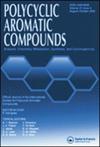Synthesis and Cytotoxicity of Novel β-Ala-Phthalazine-Based Derivatives as VEGFR2 Inhibitors and Apoptosis-Inducers Against Liver Cancer
IF 2.6
3区 化学
Q2 CHEMISTRY, ORGANIC
引用次数: 0
Abstract
Some novel β-Ala-phthalazine derivatives were synthesized from the parent methyl 3-(2-(4-benzyl-1-oxophthalazin-2(1H)-yl) acetamido)propanoate (1). Then, ester 1 underwent hydrazinolysis to produce the hydrazide 2-(4-benzyl-1-oxophthalazin-2(1H)-yl)-N-(3-hydrazineyl-3-oxo propyl) acetamide (2). Under the azide coupling technique, hydrazide 2 formed azide 3 which was further coupled with some amines and amino acid esters hydrochloride to produce the corresponding novel dipeptides 4a–h and 5a–d, respectively. Finally, hydrazide 2 was condensed and/or cyclized with some ketones and/or active methylene compounds resulting in the formation of various derivatives 6a-e. Compounds 2, 6c, and 6d demonstrated significant cytotoxicity, with IC50 values of 1.33, 0.41, and 0.38 μM compared to Sorafenib (IC50 = 2.93 μM). Compounds 6d exhibited potent VEGFR2 inhibition by 97.6% with an IC50 value of 21.9 μM compared to Sorafenib (94.7% and IC50 value of 30.1 μM). The 6d treatment significantly increased apoptotic activity by 23.6-fold, causing a halt in cell proliferation at the G2/M phase. Ultimately, it exhibited a strong affinity for the VEGFR2 protein, with a binding energy of −26.8 Kcal/mol, and it established binding contacts with the crucial amino acids involved in the interaction.
新型β- α -酞嗪类VEGFR2抑制剂和肝癌细胞凋亡诱导剂的合成及细胞毒性研究
以母体3-(2-(4-苄基-1-oxophthalazin-2(1H)-yl)乙酰氨基)丙酸甲酯(1)为原料合成了一些新的β- ala -酞嗪衍生物。然后,酯1进行肼水解,生成肼2-(4-苄基-1-oxophthalazin-2(1H)-yl)- n-(3-肼基-3-氧丙基)乙酰胺(2)。叠氮化物偶联技术下,叠氮化物2生成叠氮化物3,叠氮化物3再与一些胺和氨基酸酯盐酸盐偶联,分别生成相应的新型二肽4a-h和5a-d。最后,肼2与一些酮和/或活性亚甲基化合物缩合和/或环化,形成各种衍生物6a-e。化合物2,6c和6d具有显著的细胞毒性,IC50值分别为1.33、0.41和0.38 μM,而索拉非尼的IC50值为2.93 μM。与Sorafenib (94.7%, IC50值为30.1 μM)相比,化合物6d对VEGFR2的抑制率为97.6%,IC50值为21.9 μM。处理6d后,细胞凋亡活性明显提高23.6倍,G2/M期细胞增殖停止。最终,它对VEGFR2蛋白表现出很强的亲和力,结合能为−26.8 Kcal/mol,并与参与相互作用的关键氨基酸建立了结合接触。
本文章由计算机程序翻译,如有差异,请以英文原文为准。
求助全文
约1分钟内获得全文
求助全文
来源期刊

Polycyclic Aromatic Compounds
化学-有机化学
CiteScore
3.70
自引率
20.80%
发文量
412
审稿时长
3 months
期刊介绍:
The purpose of Polycyclic Aromatic Compounds is to provide an international and interdisciplinary forum for all aspects of research related to polycyclic aromatic compounds (PAC). Topics range from fundamental research in chemistry (including synthetic and theoretical chemistry) and physics (including astrophysics), as well as thermodynamics, spectroscopy, analytical methods, and biology to applied studies in environmental science, biochemistry, toxicology, and industry. Polycyclic Aromatic Compounds has an outstanding Editorial Board and offers a rapid and efficient peer review process, as well as a flexible open access policy.
 求助内容:
求助内容: 应助结果提醒方式:
应助结果提醒方式:


